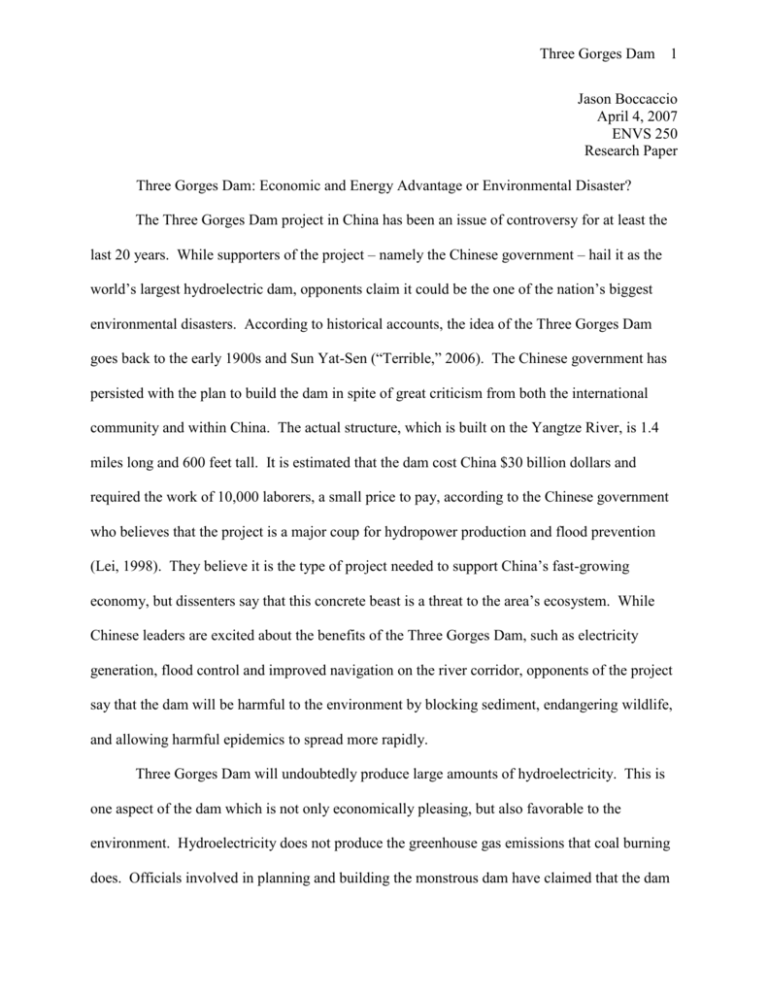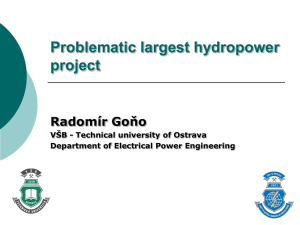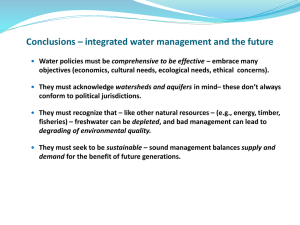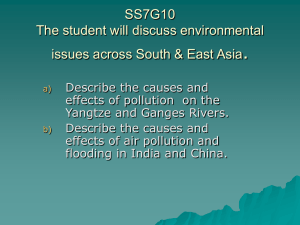here
advertisement

Three Gorges Dam 1 Jason Boccaccio April 4, 2007 ENVS 250 Research Paper Three Gorges Dam: Economic and Energy Advantage or Environmental Disaster? The Three Gorges Dam project in China has been an issue of controversy for at least the last 20 years. While supporters of the project – namely the Chinese government – hail it as the world’s largest hydroelectric dam, opponents claim it could be the one of the nation’s biggest environmental disasters. According to historical accounts, the idea of the Three Gorges Dam goes back to the early 1900s and Sun Yat-Sen (“Terrible,” 2006). The Chinese government has persisted with the plan to build the dam in spite of great criticism from both the international community and within China. The actual structure, which is built on the Yangtze River, is 1.4 miles long and 600 feet tall. It is estimated that the dam cost China $30 billion dollars and required the work of 10,000 laborers, a small price to pay, according to the Chinese government who believes that the project is a major coup for hydropower production and flood prevention (Lei, 1998). They believe it is the type of project needed to support China’s fast-growing economy, but dissenters say that this concrete beast is a threat to the area’s ecosystem. While Chinese leaders are excited about the benefits of the Three Gorges Dam, such as electricity generation, flood control and improved navigation on the river corridor, opponents of the project say that the dam will be harmful to the environment by blocking sediment, endangering wildlife, and allowing harmful epidemics to spread more rapidly. Three Gorges Dam will undoubtedly produce large amounts of hydroelectricity. This is one aspect of the dam which is not only economically pleasing, but also favorable to the environment. Hydroelectricity does not produce the greenhouse gas emissions that coal burning does. Officials involved in planning and building the monstrous dam have claimed that the dam Three Gorges Dam 2 will produce 84.7 billion kilowatts of electricity per year (Lynch, 2003). These 84.7 billion kilowatts will be produced by the dam’s 26 turbine generators. This should effectively reduce the demand for coal burning in a country that suffers from severe air pollution. Some estimates say that the dam will reduce carbon dioxide emissions by 100 million tons and conserve 50 million tons of coal each year (Lei, 1998). Besides being the world’s largest hydroelectric dam, Three Gorges is also hailed as a tool for flood control. The mighty Yangtze has always been a river prone to flooding, and government officials have always used flood control as the main justification for the dam project. In 1931, a flood ravaged the river corridor and submerged over 140,000 people and later, in 1954, a torrential flood on the Yangtze claimed the lives of 30,000 people (Lynch, 2003). While the Yangtze’s overflows do not cause as much damage and death as the floods of the Yellow River, it does flood about once every ten years. Residents of the Yangtze river corridor have long tried to defend themselves from the raging, overflowing currents of the Yangtze by building their own earthen dikes. It is said that increasing the size of these dikes would only increase the destruction if there happened to be a breach. Chinese leaders and other supporters of the Three Gorges project feel that the building the dam is most-effective way to combat the problem of flooding in the Yangtze watershed in the long-term (Hoh, 1996). The last major benefit of the dam touted by the Chinese government is its ability to facilitate navigation along the Yangtze. The size of the reservoir created by the dam could allow ships of up to 10,000 tons to reach the important industrial city, Chongqing. If commercial ships could get that far, government officials have estimated that shipping costs could be reduced by as much as 30% and Chongquing’s port could see five times the business (Lei, 1998). Allowing ocean-going ships to reach that far into China’s mainland would undoubtedly facilitate trade and Three Gorges Dam 3 serve as an additional economic benefit to the Three Gorges project (Lynch, 2003). While the dam may allow for more navigation, it will trap sediment, which would otherwise flow freely down the Yangtze and be deposited into the river delta. This sediment buildup could, in actuality, have the reverse effect of hindering navigation on the river corridor for large commercial ships. Project planners decided to build the dam in such a way that the reservoir behind it would be 175 meters deep. The rationale behind making the reservoir as deep as possible is that maximizing depth will allow more power generation. The biggest problem with creating such a large reservoir is that with an increase in depth comes in increase in the amount of silts and sediments which will build up in the impoundment. The possibility of massive sediment buildup is almost certain at Three Gorges considering the Yangtze River has the fourth largest silt load in the world, which measures in at an average of 520 million tons annually (Lei, 1998). According to environmental engineers, this type of silt buildup will severely harm water quality in the Yangtze watershed. They also advise that the dam’s sluice gates, which regulate the flow of sediment, may not work as they are designed which could lead to a disastrous, messy sediment buildup at the mouths of the Yangtze’s tributaries (“Upstream,” 2004). Project designers have planned to store water that is clear and carries less of a silt load in the months after the flood season has passed. Then, when the next flood season arrives, they hope to use the sluice gates to release water high in silt load and lower the overall water level of the reservoir by flushing out large amounts of water through the dam. The problem with this plan is that it works against the idea flood prevention and control which has always been used as a rationale for pushing the Three Gorges project to the Chinese people. If dam outflow operations follow this plan, releases of silt-laden water will be very large during the peak of Three Gorges Dam 4 flood season (Lei, 1998). If the dam’s main goal was to prevent flooding, an effort would have to be made to minimize outflows during normal flood season. At the proposed depth of 175 meters, the dam would be able to generate more hydroelectricity; however, the larger silt deposits created by making the reservoir deeper could adversely affect navigation. As previously mentioned, one of the foreseen benefits of the Three Gorges project is that it would allow massive commercial ships of up to 10,000 tons to successfully navigate the Yangtze and arrive as far as Chongquing, an important industrial city (Hoh, 1996). However, the buildup of silt caused by impeding the flows of the mighty Yangtze and its massive sediment loads could significantly clog the harbors in the Chongqing area which would block the outlet of the Jialing River as it enters the Yangtze. It is highly possible that such a large silt load would not allow large, commercial ships to reach Chongqing, thus canceling out one of the perceived economic benefits of the Three Gorges project. It is very difficult to predict the amount of silt deposit that will result in relation to how successful the planned storage and increased outflow periods are. Scientists have attempted to use mathematical models and experiments based on hydraulic data to predict how Three Gorges will handle the Yangtze’s silt load and the predicted results show that approximately 30-40% of the river’s sediment could be released from the dam within the first 30-50 years of its operation and the silt deposit and releases could be equalized at 80 years after the dam begins its operations (Lei, 1998). Because there are really no precedents for such a large scale project, predictions are exactly that; predictions. No person or mathematical model can completely forecast the effects of a project like Three Gorges Dam. There are additional problems that could be caused by the silt buildup created by Three Gorges Dam. The effects of the impeded flow of the great Yangtze are felt all the way down in Three Gorges Dam 5 the East China Sea where it deposits its fresh water and sediment load. A team of researchers has been examining the health of the East China Sea’s ecosystem since 1998. They claim that since the reservoir was filled, sediment loads in the river delta have fallen approximately 55% (Marshall, 2006). As a result of less fresh water and sediment being introduced into the sea at more erratic intervals, the numbers of phytoplankton have fallen and the remaining population has made a change from silicaceous diatoms to flagellate species. According to scientists, healthy ecosystems generally have an abundance of silicaeceous species of phytoplankton; whereas, flagellate species can kill fish populations by decreasing the water’s oxygen content and discharging toxins. A large presence of silicaceous phytoplankton is beneficial to fisheries because they are eaten and their nutritional value is passed upwards through the food chain. The stagnated water stored behind the large dam retains silicates and prevents many of them from reaching the East China Sea, which severely impacts the ecosystem and the fishery (Marshall, 2006). Moreover, the reduced sediment load robs the phytoplankton of the silicon which gives the predators which feed on them the nutrients necessary to building their shells. In another study, researchers measured sediment loads just barely downstream of the dam and found that the river carries only 20% of the sediment that it did before the dam’s construction (Perkins, 2006). According to the research team from the National Taiwan Ocean University, levels of phytoplankton in the East China Sea near the mouth of the Yangtze decreased by 86% within two months of the dam’s construction (Marshall, 2006). With this great of a reduction in phytoplankton, the researchers have predicted that yearly catch rates could drop off by approximately one million tons in comparison with catches before the dam’s construction. This would be a huge blow to the East China Sea, which is considered one of the most prolific fisheries in the world near the Yangtze delta. Three Gorges Dam 6 One of the other predicted outcomes of the sediment buildup behind Three Gorges Dam is the disappearance of tidal wetlands close to Shanghai on the Yangtze delta. The severe reduction of sediment in the dam’s discharge has caused the eroding of these valuable wetlands. The effects of this erosion of wetlands can be placed into two major categories. First, the coastal ecosystems will be severely altered. The Yangtze River creates wonderful farm-land in its valley by depositing its large silt loads into the land. The reduction of this sediment is likely to have a harmful effect on agriculture in the region. Second, the erosion of wetlands equals less land which translates into less room for the expansion and development of Shanghai; something which big business is likely to take issue with (“Dam puts,” 2006). The damming of the Yangtze will also have great effects on its own aquatic biodiversity. It will flood more than 600 kilometers of the main river channel and severely alter the habitats of many aquatic and terrestrial species (Brosse et al., 2003). Scientists say the river is home to 350 species of fish (112 of which are endemic) and 261 of these are prevalent in the upper river alone (Chang, 2001). The Three Gorges project will completely change the characteristics of the river’s main channel which will result in the loss of the natural habitats of 162 species of fish, 44 of these endemic to the region (Zhong & Power, 1996). The dam poses an especially serious threat to these endemic species. Because they only exist in this region, they could end up extinct if no serious attempts are made to conserve them. Some of the most notable endemic species in the Three Gorges region are the Chinese sturgeon, river sturgeon, and Chinese paddlefish. Numerous other migratory fish species are threatened by the dam (J Wu et al., 2004). Additionally, it is believed that the impeded flows will possibly endanger the Chinese alligator, the finless porpoise, the white crane and the Chinese River Dolphin. This river dolphin is endemic to the Yangtze and is a 30 million year old species (Topping, 1995). Three Gorges Dam 7 Brosse et al. (2003) have studied the situation and have proposed conservation efforts that would involve relocating some of these endemic species into some of the Yangtze’s upper tributaries which might provide similar habitats that could be sufficient for sustaining the existence of these endemic species. The results of such efforts are difficult to forecast. Furthermore, even if the relocations were successful in sustaining the transplanted, endemic species, they might have the undesired effects of significantly harming or even wiping out other species that naturally occur in the proposed reserves. While certain life-forms will be decimated by the damming of the Yangtze, others will flourish, which is not necessarily a good thing. The dam, when completed, is forecasted to permit the increase of serious waterborne diseases and infections. Of these, the most notable and probable to be increased are schistosomiasis and malaria. The Oriental schistosome, Schistosoma japonicum, has a long history in China. It is endemic to China and the Philippines and causes the disease, schistosomiasis japonica, in humans and animals. These schistosomes can be transmitted to humans and animals by trematode worms which live in fresh-water. During transmission, they enter the skin of humans and mammals which become the host for schistosomiasis. The problems for the host begin when the eggs of the schistosome are stuck in the liver and other tissues. The disease is often fatal. Humans and other mammals that come into contact with water that carries the parasite can be infected. Estimates say that about 865,000 humans are currently infected with the parasite in China, a much smaller number than the 12 million people who were infected in 1949 when the country first began to conduct large-scale epidemiological surveys (Mao, 1986). Scientists fear that the closure of the dam will join two endemic areas of schistosomiasis which are located on different parts of the Yangtze. This fear is well-supported by other examples of similar projects Three Gorges Dam 8 throughout the world. According to Li et al. (2001), the construction of the Aswan Dam in Egypt, the Tigay Dam in Ethiopia, the Kossou and Taabo Dams in Cote d’Ivoire, Diama Dam in Senegal, and the Manantali Dam in Mali have all sparked severe outbreaks of schistosomiasis. Nobody can totally predict how schistosomiasis will spread after the dam is fully operational, however, if history is any guide, the future of the epidemic looks bleak for those who live in the Three Gorges region. While supporters of the Three Gorges Dam project were successful in pushing it through by highlighting the perceived economic benefits (some of which are also environmentally friendly, i.e. reduced carbon emissions), it appears as though there are many more environmental risks than benefits associated with damming the mighty Yangtze River. Undoubtedly, the river’s heavy silt load will be blocked by the dam and massive sediment deposits could occur if the dam’s sluice gates do not function according to plan. This blockage of silt has many unfortunate environmental consequences for not only the region downstream of the dam, but also the areas that lie upstream of Three Gorges. The regions aquatic and terrestrial biodiversity will be impacted and the impeded, stagnated flows are likely to promote the spread of dangerous epidemics such as schistosomiasis and possibly malaria. As if these environmental problems were not alarming enough, the flooding of the reservoir area will force 1.2-1.5 million people to pick up and relocate (Li et al., 2001). While the Three Gorges project will undoubtedly have adverse effects on the region’s ecosystems, some scientists believe there are many lessons to be learned from the environmental events which will be caused by the dam for years to come. J Wu et al. (2004) contend that since the dam is already in place and nobody can turn back time and erase its effects, the scientific community needs to seize the opportunity to conduct research and learn from Three Gorges. Three Gorges Dam 9 They propose research in the areas of habitat fragmentation, impacts of habitat loss and changes on terrestrial and aquatic biodiversity, changes in water quality and biochemistry in the reservoir on aquatic biodiversity, etc. They call for a concerted effort to conduct long-term monitoring and research in the Three Gorges region. Perhaps evidence of the severe environmental impacts of the Three Gorges Dam might be used in the future to prevent another similar project from being implemented somewhere else in the world. Then again, even the most powerful evidence of adverse environmental impact may do nothing to slow a future project which promises similar prestige and short-term economic benefits. Three Gorges Dam 10 References Brosse, S., Cao, W., Chang, J., Lek, S., & Park, Y.S. (2003). Conservation strategies for endemic fish species threatened by the Three Gorges Dam. Conservation Biology, 17(6), 1748-1758. Chang, J. (2001). Conservation of endemic fish with catchment management of upper Yangtze. In King, L., Metzler, M., & Jiang, T. (Eds.), Flood risks and land use conflicts in the Yangtze catchment, China and at the Rhine River, Germany, strategies for a sustainable flood management. Frankfurt: Peter Lang Publishing. Dam puts Shanghai wetlands at the mercy of the sea. (2006). New Scientist, 189(2547), 22-22. Hoh, E. (1996). China’s greatest wall. Natural History, 105(7), 2-3. J Wu, et al. (2004). The Three Gorges Dam: an ecological perspective. Frontiers in Ecology and the Environment, 5(2), 241-248. Lei, X. (1998). Going against the flow in China. Science, 280(5360), 24-27. Li, Y., McManus, D. P., Ross, A. G., Williams, G. M., Zheng, J., (2001). Dam worms. Biologist, 48(3), 121-124. Lynch, D. L. (2003, June 2). China’s audacious dam stops flow of Yangtze. USA Today, p. 07a. Mao, S. P. (1986). Recent progress in the control of schistosomiasis in China. Chinese Medical Journal, 99, 439-443. Marshall, J. (2006). Three Gorges Dam threatens vast fishery. New Scientist, 189(2540), 18-19. Perkins, S. (2006). Three Gorges Dam is affecting ocean life. Science News, 169(20), 318-318. Terrible beauty is born. (2006). Economist, 379(8479), 39-39. Topping, A.R. (1995). Ecological roulette: Damming the Yangtze. Foreign Affairs, 74(5), 132-146. Three Gorges Dam 11 Upstream, first of many treatment plants tackles pollution. (2004). ENR: Engineering NewsRecord, 253(8), 23-23. Zhong, Y. & Power, G. (1996). Environmental impacts of hydroelectric projects on fish resources in China. Regulated Rivers: Research and Management, 12, 81-98.








